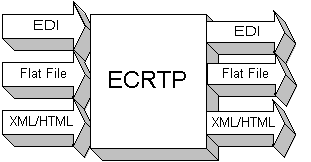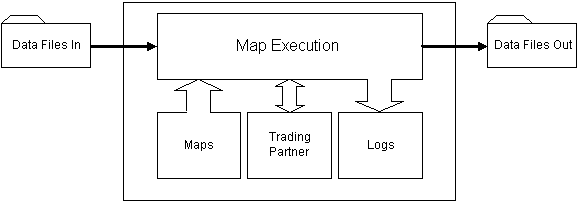ECRTP is a data transformation engine. It analyzes, transforms, and routes messages. There are many types of message transformations:

EDI to flat file – interprets incoming EDI-formatted data and translates it into a user-defined file format. Performed by inbound maps.
EDI to EDI – interprets incoming EDI-formatted data and translates it into another EDI format. Performed by any-to-any maps.
EDI to XML/HTML – interprets incoming EDI-formatted data and translates it into XML or HTML-formatted data. Performed by web maps (special any-to-any maps).
Flat file to EDI – interprets a user-defined file and translates it to an EDI standard or to other standard message formats. Performed by outbound maps.
Flat file to flat file – interprets a user-defined file and translates it into another user-defined format. Performed by any-to-any maps.
Flat file to XML/HTML – interprets a user-defined file and translates it into XML or HTML-formatted data. Performed by web maps (special any-to-any maps).
XML/HTML to EDI – interprets XML or HTML-formatted data and translates it to an EDI standard or to other standard message formats. Performed by web maps (special any-to-any maps).
XML/HTML to flat file – interprets XML or HTML-formatted data and translates it into a user-defined format. Performed by web maps (special any-to-any maps).
XML/HTML to XML/HTML – interprets XML or HTML-formatted data and translates it into XML or HTML-formatted data. Performed by web maps (special any-to-any maps).
ECRTP consists of the following components: map files, trading partner database, and log files.
The map files contain the business rules and logic that define the relationships between the incoming and outgoing data.
The trading partner database contains information that is used to route messages between trading partners and to select the specific map that should be run.
The log files maintain an audit trail of the transaction processing.
Figure 1-2: Map execution flow chart
